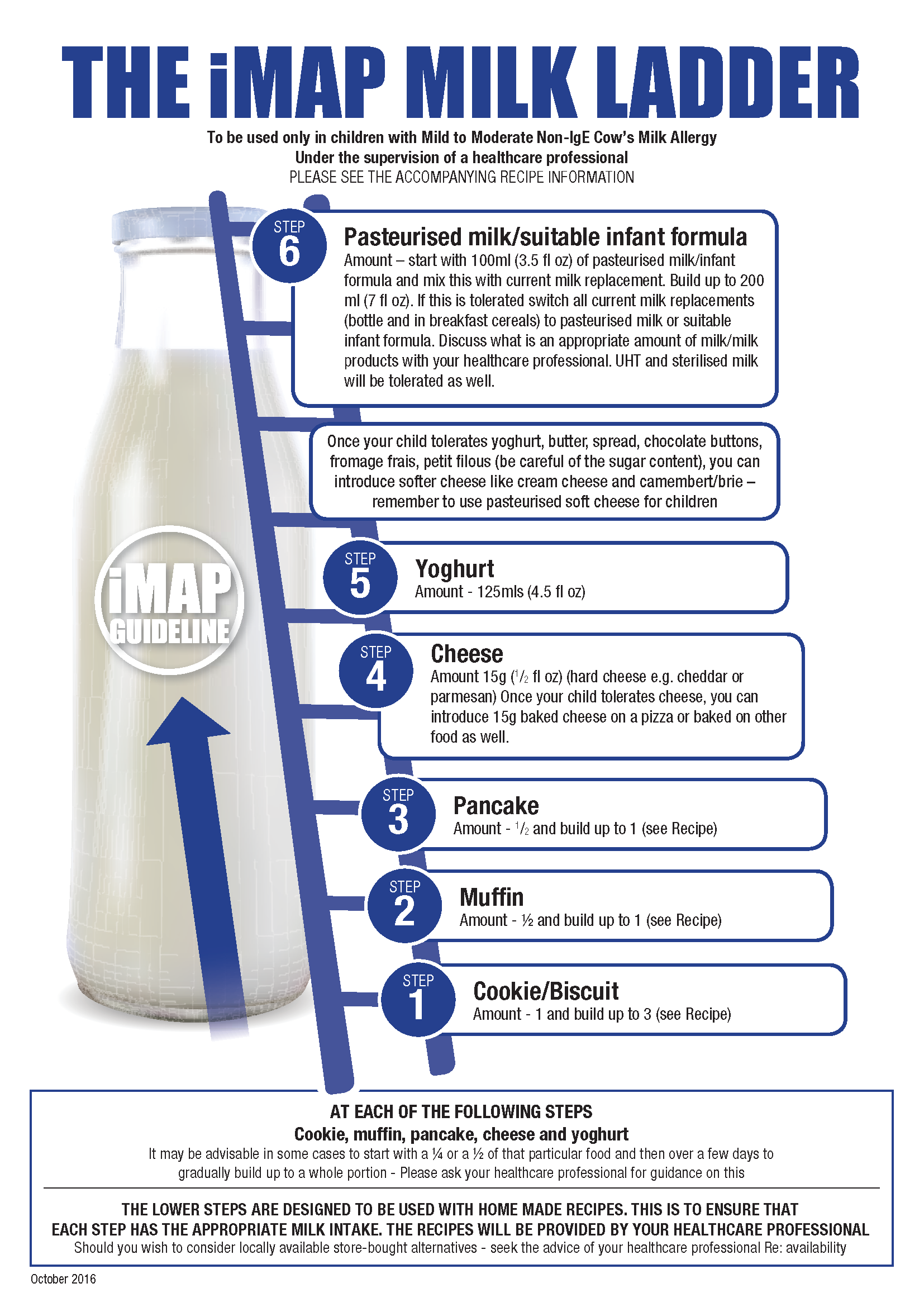The Milk Ladder - has my baby grown out of Cow's Milk Protein Allergy?
All standard infant formula (eg SMA, Comfort milk, Cow & Gate, Aptamil) contains cow’s milk protein.
An assessment of your child’s allergy, medical history and/or results indicate that it is time to see if they have outgrown their food allergy. This can be done by adding milk into the diet gradually at home.
Milk is introduced into the diet by following a ‘milk ladder’ where each food contains increasing levels of milk protein. It is important to start with well-cooked/processed milk first before progressing to ‘uncooked’ dairy products. This ‘milk ladder’ is based on scientific research.
Remember, these foods are part of a mixed diet and are not expected to be a significant part of the child’s diet. The Milk Ladder should only be used:
- In children with mild to moderate delayed (non-IgE) cow’s milk protein allergy symptoms (watch the film cow’s milk allergy explained if you are unsure of the type of reaction your baby has had)
- Baby/child has been milk free for 6 months and can manage to eat foods on the milk ladder
- Your child is well
Do NOT start this challenge if:
- Your child has had either immediate symptoms (within an hour of eating/drinking dairy) or a positive blood or skin test (specific IgE or Skin Prick Test) to cow's milk
- Your child is unwell, e.g. cold or chest infection etc
- Your child has any tummy/bowel problems e.g. tummy ache or loose nappies
- Your child has any ‘teething’ signs that are upsetting your child
- Atopic dermatitis (eczema) has flared up
- Your child is having any medication which may upset their tummy, e.g. antibiotics.
Throughout the challenge, it is useful to keep a record of the foods tried/the amounts eaten and any reaction (including how long after the food was eaten did the reaction occur). Each of the foods listed contain progressively more milk protein. The time spent in each step will vary for one child to another depending on how they presented. Each step will take at least 3 days to a week but it is fine to go slower than this if needed.
The Milk Ladder
Click image to expand/download or print
The lower steps of the milk ladder are designed to be used with homemade recipes to ensure that each step has the appropriate milk intake. You can ask your health professional (dietician) for further guidance on the steps or for recipes if needed.
Step 1:
Start with ¼ of biscuit on the first morning, if no symptoms, give half a biscuit the next day and gradually increase till they can have 3 biscuits a day without any problems. If using store-bought biscuits rather than homemade look for a biscuit that contains milk powder as one of its ingredients.
Step 2:
Start with ¼ to ½ a muffin and build up to one muffin.
Step 3:
Start with ¼ to ½ a pancake and build up to one. If using store-bought pancakes, they should contain milk protein as one of its ingredients. (Pancakes contain less milk than muffins but are cooked for a shorter time).
Step 4:
Start with a thin slice of hard cheese such as cheddar or parmesan. Increase the amount gradually until your child is eating 15g baked cheese e.g. on a pizza or lasagne.
Step 5:
Start with one small teaspoon of yoghurt and increase daily until eating 125 mls (4.5 oz) yoghurt. Once your child tolerates yogurt you can include butter, chocolate buttons and cream cheese. Once your child tolerates yoghurt, butter, spread, chocolate buttons, fromage frais, petit filous (be careful of the sugar content), you can introduce softer cheese like cream cheese and camembert/brie –remember to use pasteurised soft cheese for children.
Step 6:
Pasteurised milk (or suitable infant formula). Introduce 100ml (3.5 oz) pasteurised cow’s milk or infant formula (powder) and mix with current milk replacement. Build up to 200 mls. (7 fl oz.) If this is tolerated switch all current milk replacements to pasteurised milk or suitable infant formula. UHT and sterilised milk will be tolerated as well.
Some children may be able to tolerate a certain amount of cow’s milk in their diet If they have more than the amount that they are able to tolerate then they may develop symptoms (up to 48 hours later). If this is the case it is sensible to include dairy products and cow’s milk up to the amount they can tolerate while remaining symptom free.
If the food at any step of the ladder is tolerated, your child should continue to consume this (as well as all foods in the previous steps) and then try the food in the next agreed step.
If the child does not tolerate the food in a particular step, simply go back to the previous step. Re-try again in 2-3 months to check if able to progress.
Related pages: Is it cow's milk allergy,home milk challenge,milk free diet for breastfeeding mums, milk free diet for babies, milk and soya free diet for babies




